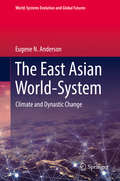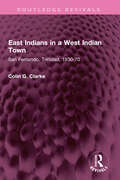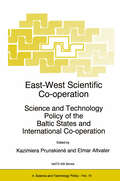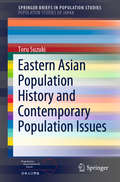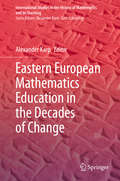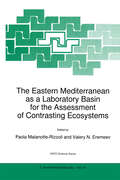- Table View
- List View
Earth Science Satellite Applications: Current and Future Prospects (Springer Remote Sensing/Photogrammetry)
by Faisal HossainThe combined observational power of the multiple earth observing satellites is currently not being harnessed holistically to produce more durable societal benefits. We are not able to take complete advantage of the prolific amount of scientific output and remote sensing data that are emerging rapidly from satellite missions and convert them quickly into decision-making products for users. The current application framework we have appears to be an analog one lacking the absorption bandwidth required to handle scientific research and the voluminous (petabyte-scale) satellite data. This book will tackle this question: "How do we change this course and take full advantage of satellite observational capability for a more sustainable, happier and safer future in the coming decades?"
Earth System Modelling - Volume 2: Algorithms, Code Infrastructure and Optimisation (SpringerBriefs in Earth System Sciences)
by Luca Bonaventura René Redler Reinhard BudichCollected articles in this series are dedicated to the development and use of software for earth system modelling and aims at bridging the gap between IT solutions and climate science. The particular topic covered in this volume addresses the historical development, state of the art and future perspectives of the mathematical techniques employed for numerical approximation of the equations describing atmospheric and oceanic motion. Furthermore, it describes the main computer science and software engineering strategies employed to turn these mathematical methods into effective tools for understanding earth's climate and forecasting its evolution. These methods and the resulting computer algorithms lie at the core of earth system models and are essential for their effectiveness and predictive skill.
Earthquake Data in Engineering Seismology: Predictive Models, Data Management and Networks (Geotechnical, Geological and Earthquake Engineering #14)
by Sinan Akkar, Polat Gülkan and Torild van EckThis book addresses current activities in strong-motion networks around the globe, covering issues related to designing, maintaining and disseminating information from these arrays. The book is divided into three principal sections. The first section includes recent developments in regional and global ground-motion predictive models.It presents discussions on the similarities and differences of ground motion estimations from these models and their application to design spectra as well as other novel procedures for predicting engineering parameters in seismic regions with sparse data. The second section introduces topics about the particular methodologies being implemented in the recently established global and regional strong-motion databanks in Europe to maintain and disseminate the archived accelerometric data. The final section describes major strong-motion arrays around the world and their historical developments. The last three chapters of this section introduce projects carried out within the context of arrays deployed for seismic risk studies in metropolitan areas. Audience: This timely book will be of particular interest for researchers who use accelerometric data extensively to conduct studies in earthquake engineering and engineering seismology.
Earthquake Hazard and Risk (Advances in Natural and Technological Hazards Research #6)
by Vladimír SchenkEarthquake Hazard and Risk is a book summarizing selected papers presented at the 27th General Assembly of the International Association of Seismology and Physics of the Earth's Interior (Wellington, January 1994). The papers, rigorously scrutinized by an international board of referees, cover some recent aspects of current research in earthquake hazard and seismic risk. They address the algorithms and methodology used in seismological applications, the reliability of these techniques with the decreasing level of probability and uncertainty associated with various seismotectonic settings, the physical and statistical nature of earthquake occurrences, strong ground motions and effects of surface seismogeological conditions. A special effort has been made to include papers that illustrate the assessment of earthquake hazard and seismic risk through applications at sites in either inter-plate or intra-plate tectonic settings. Of particular interest is hazard assessment in regions of rare large earthquakes. The book is suitable for those interested in earthquake hazard and seismic risk research as well as a more general audience of seismologists, geophysicists and Earth scientists. It is also useful for authorities responsible for public safety and natural hazard mitigation plans and for insurance companies.
Earthquake Occurrence: Short- and Long-term Models and their Validation
by Rodolfo Console Maura Murru Giuseppe FalconeEarthquake Occurrence provides the reader with a review of algorithms applicable for modeling seismicity, such as short-term earthquake clustering and pseudo-periodic long-term behavior of major earthquakes. The concept of the likelihood ratio of a set of observations under different hypotheses is applied for comparison among various models. In short-term models, known by the term ETAS, the occurrence space and time rate density of earthquakes is modeled as the sum of two terms, one representing the independent or spontaneous events, and the other representing the activity triggered by previous earthquakes. Examples of the application of such algorithms in real cases are also reported. Dealing with long-term recurrence models, renewal time-dependent models, implying a pseudo-periodicity of earthquake occurrence, are compared with the simple time-independent Poisson model, in which every event occurs regardless of what has occurred in the past. The book also introduces a number of computer codes developed by the authors over decades of seismological research.
Earthquake Occurrence: Short- and Long-term Models and their Validation
by Rodolfo Console Maura Murru Giuseppe FalconeEarthquake Occurrence provides the reader with a review of algorithms applicable for modeling seismicity, such as short-term earthquake clustering and pseudo-periodic long-term behavior of major earthquakes. The concept of the likelihood ratio of a set of observations under different hypotheses is applied for comparison among various models. In short-term models, known by the term ETAS, the occurrence space and time rate density of earthquakes is modeled as the sum of two terms, one representing the independent or spontaneous events, and the other representing the activity triggered by previous earthquakes. Examples of the application of such algorithms in real cases are also reported. Dealing with long-term recurrence models, renewal time-dependent models, implying a pseudo-periodicity of earthquake occurrence, are compared with the simple time-independent Poisson model, in which every event occurs regardless of what has occurred in the past. The book also introduces a number of computer codes developed by the authors over decades of seismological research.
Earthquake Science and Seismic Risk Reduction (NATO Science Series: IV: #32)
by Robert J. Geller FrancescoMulargiaWhat is the first thing that ordinary people, for whom journalists are the proxy, ask when they meet a seismologist? It is certainly nothing technical like "What was the stress drop of the last earthquake in the Imperial Valley?" It is a sim ple question, which nevertheless summarizes the real demands that society has for seismology. This question is "Can you predict earthquakes?" Regrettably, notwithstanding the feeling of omnipotence induced by modem technology, the answer at present is the very opposite of "Yes, of course". The primary motivation for the question "Can you predict earthquakes?" is practical. No other natural phenomenon has the tremendous destructive power of a large earthquake, a power which is rivaled only by a large scale war. An earth quake in a highly industrialized region is capable of adversely affecting the econ omy of the whole world for several years. But another motivation is cognitive. The aim of science is 'understanding' nature, and one of the best ways to show that we understand a phenomenon is the ability to make accurate predictions.
Earthquake Statistical Analysis through Multi-state Modeling
by Irene Votsi Nikolaos Limnios Eleftheria Papadimitriou Georgios TsaklidisEarthquake occurrence modeling is a rapidly developing research area. This book deals with its critical issues, ranging from theoretical advances to practical applications. The introductory chapter outlines state-of-the-art earthquake modeling approaches based on stochastic models. Chapter 2 presents seismogenesis in association with the evolving stress field. Chapters 3 to 5 present earthquake occurrence modeling by means of hidden (semi-)Markov models and discuss associated characteristic measures and relative estimation aspects. Further comparisons, the most important results and our concluding remarks are provided in Chapters 6 and 7.
Earthquake Statistical Analysis through Multi-state Modeling
by Irene Votsi Nikolaos Limnios Eleftheria Papadimitriou Georgios TsaklidisEarthquake occurrence modeling is a rapidly developing research area. This book deals with its critical issues, ranging from theoretical advances to practical applications. The introductory chapter outlines state-of-the-art earthquake modeling approaches based on stochastic models. Chapter 2 presents seismogenesis in association with the evolving stress field. Chapters 3 to 5 present earthquake occurrence modeling by means of hidden (semi-)Markov models and discuss associated characteristic measures and relative estimation aspects. Further comparisons, the most important results and our concluding remarks are provided in Chapters 6 and 7.
Earthquakes, Tsunamis and Nuclear Risks: Prediction and Assessment Beyond the Fukushima Accident
by Katsuhiro KamaeThis book covers seismic probabilistic risk assessment (S-PRA) and related studies which have become more important to increase the safety of nuclear facilities against earthquakes and tsunamis in the face of the many uncertainties after the Fukushima accident. The topics are (1) Active faults and active tectonics important for seismic hazard assessment of nuclear facilities,(2) Seismic source modeling and simulation and modeling techniques indispensable for strong ground motion prediction, and (3) PRA with external hazard and risk communication. The Fukushima accident has showed us the limitations of the deterministic evaluation approach to external events (an earthquake and tsunami) in which there are many uncertainties. Furthermore, public anxiety regarding nuclear safety because of an unexpected threat caused by an earthquake or tsunami is growing. The current policy on the estimation of the design basis of ground motion as well as tsunami height still has not been improved following the Fukushima accident. In particular, the risk concept in a nuclear system regarding seismic motion and a tsunami beyond the design basis is indispensable. Therefore, research and development for PRA enhancing nuclear safety are being actively pursued not only in Japan but also worldwide. This book provides an opportunity for readers to consider the future direction of nuclear safety vis-à-vis natural disasters.
The East Asian World-System: Climate and Dynastic Change (World-Systems Evolution and Global Futures)
by Eugene N. AndersonThis book studies the East Asian world-system and its dynastic cycles as they were influenced by climate and demographic change, diseases, the expansion of trade, and the rise of science and technology. By studying the history of East Asia until the beginning of the 20th century and offering a comparative perspective on East Asian countries, including China, Japan and Korea, it describes the historical evolution of the East Asian world-system as being the result of good or poor management of the respective populations and environments. Lastly, the book discusses how the East Asian regions have become integrated into a single world-system by a combination of trade, commerce, and military action. Given its scope, the book will appeal to scholars of history, sociology, political science and environmental studies, and to anyone interested in learning about the effects of climate change on the dynamic development of societies.
East European Transition and EU Enlargement: A Quantitative Approach (Contributions to Economics)
by Wojciech W. Charemza Krystyna StrzalaIn March 1998 the European Union formally launched the accession process that will lead to a significant enlargement of the Union. So far ten countries from Central Europe: Bulgaria, the Czech Republic, Estonia, Hungary, Latvia, Lithuania, Poland, Romania, the Slovak Republic and Slovenia have submitted their applications for EU membership. This unique process immediately attracted attention of economists and policy makers. Nevertheless, it can be noticed that among numerous results already published, there is a distinctive shortage of books and papers in which quantitative research methods are applied. This is to a large extent justified by the fact that the transition and accession processes are new to the economic sciences, their methodology is not wellresearched, statistical data for the Central and East European countries are scarce and not always reliable and, generally, quantitative approach seems to be a risky and uncertain business. All these all problems can also be seen as a challenge rather than an obstacle. With this on mind, we have decided to clarify the status quo by organising a research seminar which focused on the methodology and quantitative analysis of the Central and East European transition and pre-accession processes. The seminar, East European Transition and EU Enlargement: a Quantitative Approach organised by Macroeconomic and Financial Data Centre (University of Gdansk and University ofLeicester) took place in Gdansk in June 2001. Our edited volume contains papers developed from this seminar.
East Indians in a West Indian Town: San Fernando, Trinidad, 1930-70 (Routledge Revivals)
by Colin G ClarkeFirst published in 1986, East Indians in a West Indian Town explores the complex geographical, sociological and anthropological dimensions of Trinidad society before and after its political independence, by employing three sets of materials – census data, questionnaires and participant-observation records. Cartographic, humanistic and statistical approaches are combined in a historical perspective to deal with the significance of race, cultural distinctions and class in San Fernando. A major concern of the book is to examine the social complexity that lies behind geographical patterns, and to compare aggregate data with group behaviour. This book will be of interest to students of geography, sociology and anthropology.
East Indians in a West Indian Town: San Fernando, Trinidad, 1930-70 (Routledge Revivals)
by Colin G ClarkeFirst published in 1986, East Indians in a West Indian Town explores the complex geographical, sociological and anthropological dimensions of Trinidad society before and after its political independence, by employing three sets of materials – census data, questionnaires and participant-observation records. Cartographic, humanistic and statistical approaches are combined in a historical perspective to deal with the significance of race, cultural distinctions and class in San Fernando. A major concern of the book is to examine the social complexity that lies behind geographical patterns, and to compare aggregate data with group behaviour. This book will be of interest to students of geography, sociology and anthropology.
East-West Scientific Co-operation: Science and Technology Policy of the Baltic States and International Co-operation (NATO Science Partnership Subseries: 4 #15)
by Kazimiera PrunskienėAll former Soviet Union countries experience their past as a heavy burden. It led to the centralisation of scientific personnel, the separation of research from teaching at universities, and a concentration of certain branches of technology in different parts of the Union. This has given rise to a one-sided technology and science potential which frequently cannot be sufficiently supported due to a lack of adequate finance. Cooperation between the Baltic States themselves is often hampered by an exaggerated sense of national identity, and international cooperation can be made difficult by linguistic problems. A critical issue is finance. The Baltic States themselves are experiencing budgetary constraints, and the West is cutting back on funding. The analytical issues dealt with here include specific questions, such as in the sectors of energy policy, electrical equipment and electronics, and environmental considerations. The transfer of technology is also discussed, as is security: there is the possibility that science and scientific results can be obtained from the former Soviet Union at low cost by the criminal community.
Eastern Asian Population History and Contemporary Population Issues (SpringerBriefs in Population Studies)
by Toru SuzukiThis book interprets and explains contemporary population issues from historical and cultural perspectives. These include lowest-low fertility in the Republic of Korea and Taiwan, early population aging in China relative to the developmental level, and various modes of domestic and international migration in the region. The book shows that divergent fertility decline can be attributed to the family patterns established in the pre-modern era in each country. It also examines the diversity of international migration in Eastern Asian countries today is also understood from the long-term historical view.
Eastern European Mathematics Education in the Decades of Change (International Studies in the History of Mathematics and its Teaching)
by Alexander KarpThis contributed volume is devoted to the recent history and evolution of mathematics education in Eastern Europe, exploring how it was influenced by social and political changes in this part of the world. Despite the broad recognition of the importance of these changes, little scholarship exists that examines the ways in which they were followed by changes in the teaching of mathematics in the post-socialist countries. Indeed, the analyzed processes are complex and vary across the states. Accordingly, this book touches on many factors--including differences in cultures and traditions – that find expression in the teaching of mathematics. Specifically, this volume seeks to explore what changes there were in education in general and in the position of mathematics in school education in these years, and how these changes may be explained and documented; what changes there were in the content of mathematics education and its assessment, and how were they motivated and adopted; what new textbooks appeared and what new methodological ideas were offered in them; how and why mathematics teacher education and/or professional development changed; what was the role (if any) of foreign influences on mathematics education, etc.The book will be of interest to both researchers in mathematics education and practitioners-teachers, as well as a broader audience of historians and educators exploring the political aspects of education.
The Eastern Mediterranean as a Laboratory Basin for the Assessment of Contrasting Ecosystems (NATO Science Partnership Subseries: 2 #51)
by Valery N. Eremeev PaolaMalanotte-RizzoliThis book is the outcome of a NATO Advanced Research Workshop on "The Eastern Mediterranean as a laboratory basin for the assessment of contrasting ecosystems" that was held in Kiev, Ukraine, March 23-27, 1998. The scientific rationale of the workshop can be summarized as follows. The Eastern Mediterranean is the most nutrient impoverished and oligotrophic large water body known. There is a well-defined eastward trend in nutrient ratios over the entire Mediterranean that starts at the Gibraltar Straits and, through the western basin, proceeds to the Ionian and Levantine Seas. Supply of nutrients to the entire Mediterranean is limited by inputs from the North Atlantic and various river systems along the sea. The unique feature of the Mediterranean is the presence of an eastward longitudinal trend in available nitrate/phosphate ratios. This apparently induces a west-to-east variation in the structure of the pelagic food web and trophic interactions. In this context the Mediterranean, and in particular its Eastern basin, provides probably a unique platform to explore the hypotheses related to the suggested phosphate-limitation on production and to the shift between "microbial" and "classical" modes of operation of the photic food web. The major exception of the overall oligotrophic nature of the Eastern Mediterranean is the highly eutrophic system of the Northern Adriatic Sea. Here, during the last two decades the discharges of the northern rivers (especially of the Po), together with municipal sewage, have led to a very marked increase of nutrients and subsequent imponent eutrophication events.
Easy as π?: An Introduction to Higher Mathematics
by Oleg A. IvanovAn introduction for readers with some high school mathematics to both the higher and the more fundamental developments of the basic themes of elementary mathematics. Chapters begin with a series of elementary problems, cleverly concealing more advanced mathematical ideas. These are then made explicit and further developments explored, thereby deepending and broadening the readers' understanding of mathematics. The text arose from a course taught for several years at St. Petersburg University, and nearly every chapter ends with an interesting commentary on the relevance of its subject matter to the actual classroom setting. However, it may be recommended to a much wider readership; even the professional mathematician will derive much pleasureable instruction from it.
Easy as Pi: Maths Made Simple
by Liz StrachanIf you're brilliant at everything else, but lack confidence when it comes to maths, join Liz Strachan, a maths teacher with many, many years of experience, on this magical tour through the seeming mysteries of numbers, algebra and geometry.In the same inimitable, entertaining way she did in her previous bestselling books, A Slice of Pi and Numbers Are Forever, Liz will take readers from number-phobics to mathematical know-it-alls in no time at all. Peppered with absolutely terrible maths jokes and quirkily illustrated by Steven Appleby, this light-hearted but informative book will appeal to anyone with an enquiring mind.
The Easy Guide to Repertory Grids
by Devi JankowiczA user-friendly introduction to the powerful mental mapping tool of repertory grid technique. Repertory grid technique is a system for identifying, in detail, what you or anyone else really thinks about an issue. You can use it as a tool for personal discovery, as a device for team building activities, or as a problem-solving aid. Written as a DIY guide, with a friendly expert sitting beside you, this book will teach you the technique of repertory grids step by step. Here you'll find all the information you need, alongside lots of worked examples and helpful exercises that you can use to check your understanding. The answers are in the back! If you want additional practice and resources a website that supports this book can be found at www.wiley.co.uk/easyguide Professor Devi Jankowicz is one of the leading authorities on occupational applications of personal construct theory and repertory grid technique. He has written this guide for psychology students and researchers; education students; personnel practitioners; as well as managers in the workplace. "This book's title may seem a contradiction in terms to readers who have seen the repertory grid as dauntingly complex. However, the book lives up to its title in being a very user-friendly introduction to the technique, written in a chatty style, and including numerous practical exercises, mostly not requiring use of computer software." - David Winter University of Hertfordshire and Barnet, Enfield and Haringey Mental Health NHS Trust
Easy Learning, Maths: Age 9-10 (PDF)
by Collins Easy LearningCollins Easy Learning Maths Age 9-10 develops numeracy skills, gives support, practice and guidance for year-by-year school learning.
Easy Mathematics for Biologists
by Peter C. FosterBecause elementary mathematics is vital to be able to properly design biological experiments and interpret their results. As a student of the life sciences you will only make your life harder by ignoring mathematics entirely. Equally, you do not want to spend your time struggling with complex mathematics that you will never use. This book is the pe
An Easy Path to Convex Analysis and Applications (Synthesis Lectures on Mathematics & Statistics)
by Boris Mordukhovich Nguyen MauConvex optimization has an increasing impact on many areas of mathematics, applied sciences, and practical applications. It is now being taught at many universities and being used by researchers of different fields. As convex analysis is the mathematical foundation for convex optimization, having deep knowledge of convex analysis helps students and researchers apply its tools more effectively. The main goal of this book is to provide an easy access to the most fundamental parts of convex analysis and its applications to optimization. Modern techniques of variational analysis are employed to clarify and simplify some basic proofs in convex analysis and build the theory of generalized differentiation for convex functions and sets in finite dimensions. We also present new applications of convex analysis to location problems in connection with many interesting geometric problems such as the Fermat-Torricelli problem, the Heron problem, the Sylvester problem, and their generalizations. Of course, we do not expect to touch every aspect of convex analysis, but the book consists of sufficient material for a first course on this subject. It can also serve as supplemental reading material for a course on convex optimization and applications.
An Easy Path to Convex Analysis and Applications (Synthesis Lectures on Mathematics & Statistics)
by Boris Mordukhovich Nguyen Mau NamThis book examines the most fundamental parts of convex analysis and its applications to optimization and location problems. Accessible techniques of variational analysis are employed to clarify and simplify some basic proofs in convex analysis and to build a theory of generalized differentiation for convex functions and sets in finite dimensions. The book serves as a bridge for the readers who have just started using convex analysis to reach deeper topics in the field. Detailed proofs are presented for most of the results in the book and also included are many figures and exercises for better understanding the material. Applications provided include both the classical topics of convex optimization and important problems of modern convex optimization, convex geometry, and facility location.








